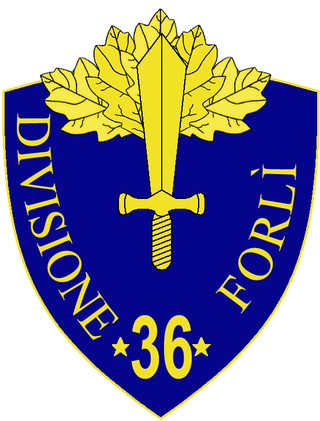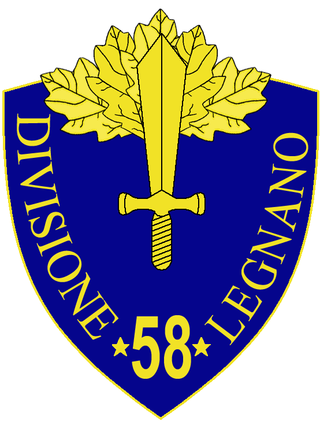Related Research Articles
The 1st Army Corps was first formed before World War I. During World War II it fought in the Campaign for France in 1940, on the Mediterranean islands of Corsica and Elba in 1943 - 1944 and in the campaigns to liberate France in 1944 and invade Germany in 1945.

The 30th Infantry Division "Sabauda" was an infantry division of the Royal Italian Army during World War II. The Sabauda was based in Cagliari in Sardinia and named for the Latin name of the Royal House of Savoy. After the announcement of the Armistice of Cassibile on 8 September 1943 the division joined the Italian Co-belligerent Army.

The 340th Volksgrenadier Division was a volksgrenadier division of the German Army during the Second World War, active from 1944 to 1945.
The 184th Infantry Division "Nembo" was an airborne division of the Royal Italian Army during World War II. After the Armistice of Cassibile the division joined the Italian Co-belligerent Army's Italian Liberation Corps and together with the Polish II Corps liberated Ancona in the Battle of Ancona.
The 208th Coastal Division was an infantry division of the Royal Italian Army during World War II. Royal Italian Army coastal divisions were second line divisions formed with reservists and equipped with second rate materiel. Recruited locally, they were often commanded by officers called out of retirement.

The 36th Infantry Division "Forlì" was a infantry division of the Royal Italian Army during World War II. The Forlì was classified as a mountain infantry division, which meant that the division's artillery was moved by pack mules instead of the horse-drawn carriages of line infantry divisions. Italy's real mountain warfare divisions were the six alpine divisions manned by Alpini mountain troops. The division was formed on 31 March 1939 and named for the city of Forlì. The division was based in Saluzzo and most of its troops were drafted in the surrounding Langhe region in southern Piedmont. The division's two infantry regiments were based in Alba (43rd) and Saluzzo (44th), with the division's artillery regiment also based in Saluzzo.

The 31st Infantry Division "Calabria" was an infantry division of the Royal Italian Army during World War II. The Calabria was formed in Sassari and named for the region of Calabria. The division was part of the garrison of Sardinia, where it remained until the Armistice of Cassibile, after which it served in the Italian Co-belligerent Army.
The 203rd Coastal Division was an infantry division of the Royal Italian Army during World War II. Royal Italian Army coastal divisions were second line divisions formed with reservists and equipped with second rate materiel. Recruited locally, they were often commanded by officers called out of retirement.
The 204th Coastal Division was an infantry division of the Royal Italian Army during World War II. Royal Italian Army coastal divisions were second line divisions formed with reservists and equipped with second rate materiel. Recruited locally, they were often commanded by officers called out of retirement.
The 205th Coastal Division was an infantry division of the Royal Italian Army during World War II. Royal Italian Army coastal divisions were second line divisions formed with reservists and equipped with second rate materiel. Recruited locally, they were often commanded by officers called out of retirement.
The 211th Coastal Division was an infantry division of the Royal Italian Army during World War II. Royal Italian Army coastal divisions were second line divisions formed with reservists and equipped with second rate materiel. They were often commanded by officers called out of retirement.

The 44th Infantry Division "Cremona" was an infantry division of the Royal Italian Army during World War II. The Cremona was formed on 24 August 1939 by splitting the 20th Infantry Division "Curtatone and Montanara" into the 20th Infantry Division "Friuli" and 44th Infantry Division "Cremona". The division was named for the city of Cremona. The division served as occupation force on Corsica and fought German units after the Armistice of Cassibile was announced on 8 September 1943. The division then served with the Italian Co-belligerent Army and remained active until the 1975 Italian Army reform.
The 212th Coastal Division was an infantry division of the Royal Italian Army during World War II. Royal Italian Army coastal divisions were second line divisions formed with reservists and equipped with second rate materiel. They were often commanded by officers called out of retirement.
The 222nd Coastal Division was an infantry division of the Royal Italian Army during World War II. Royal Italian Army coastal divisions were second line divisions formed with reservists and equipped with second rate materiel. They were often commanded by officers called out of retirement.

The 58th Infantry Division "Legnano" was an infantry division of the Royal Italian Army during World War II. The Legnano's predecessor division was formed on 8 February 1934 in Milan and named for the medieval Battle of Legnano. On 24 May 1939 the division split to form the 6th Infantry Division "Cuneo" and the 58th Infantry Division "Legnano". After the announcement of the Armistice of Cassibile the Legnano resisted the invading German forces. The division's staff and 67th Infantry Regiment "Legnano" were used to form the first unit of the Italian Co-belligerent Army, which fought on the allied side in the Italian campaign. On 17 February 1944 the division's last units joined other commands and the division was officially dissolved.

Antonio Basso was an Italian general during World War II.
The VII Army Corps was a corps of the Royal Italian Army between 1877 and 1944.
The XXX Army Corps was a corps of the Royal Italian Army between 1915 and 1943. It was also known as Special Army Corps between November 1940 and June 1941.
The XXXI Army Corps was a corps of the Royal Italian Army between 1941 and 1944.
The IX Army Corps was a corps of the Royal Italian Army between 1877 and 1944.